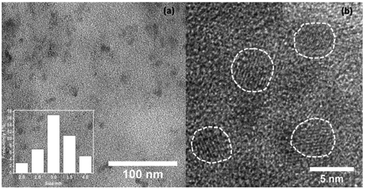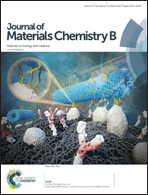Highly luminescent, heteroatom-doped carbon quantum dots for ultrasensitive sensing of glucosamine and targeted imaging of liver cancer cells†
Abstract
A novel fluorescent boronate nanoprobe has been synthesized by judiciously doping boron, nitrogen, and sulphur in carbon quantum dots (BNSCQD). Specifically, the synergistic presence of nitrogen and sulphur along with boronic acid provides excellent luminescence properties and offers recognition sites for specific sensing of glucosamine. Fluorescence intensity enhances in the presence of glucosamine because of agglomeration of luminescent centers, and thus restricts nonradiative emission channels. The detection limit of this turn on fluorescence for glucosamine is 0.7 nM in PBS. Following this protocol, for the first time, a paper based sensor strip has been prepared for naked eye detection of glucosamine with an LOD of 2.5 μM. The developed nanoprobe shows very low cytotoxicity. More interestingly, boronic acid located on the surface of BNSCQD offers molecular recognition sites for the sialyl Lewisa receptor, which is overexpressed on the surface of liver cancer cells (HepG2). The selective uptake of the BNSCQD nanoprobe in HepG2 cells compared to L929, 3T3 and PC3 cells shows its cell targeting capability.



 Please wait while we load your content...
Please wait while we load your content...